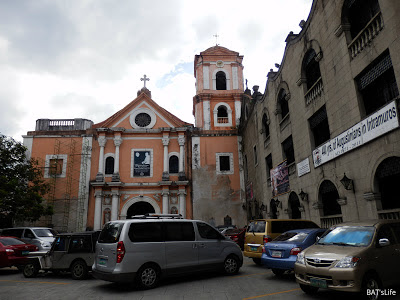San Agustin Church (Intramuros, Manila)
The oldest church in the Philippines is found inside Intramuros, Manila. While hearing mass inside the San Agustin Church, it is easy to imagine how life was during the Spanish times. Perhaps, during those times attending mass and other religious events were one big occasion. It is not an ordinary affair. Hearing mass is not only an obligation but a well-attended affair. Everyone gears up for the occasion and are on their Sunday's best. Females are required to wear a veil inside the church. Most were extremely religious and failing to show up during mass is considered a mortal sin. It is sad that I cannot say the same today.
 While inside San Agustin Church, I cannot help thinking how life was in the walled city during the time of Rizal? The walls that surround Intramuros have definitely segregated the people during his time. Those inside the walls are considered to belong to the higher class of society while the rest belongs to the lower echelon. It is a privilege to live within the walled city and to be able to attend mass in churches inside Intramuros was an honor. The church is a place where different personalities inside the walled city converge. The church gathers people from all walks of life - from the highest government official, religious authorities, beautiful maidens, urchins, peddlers and the common folk.
While inside San Agustin Church, I cannot help thinking how life was in the walled city during the time of Rizal? The walls that surround Intramuros have definitely segregated the people during his time. Those inside the walls are considered to belong to the higher class of society while the rest belongs to the lower echelon. It is a privilege to live within the walled city and to be able to attend mass in churches inside Intramuros was an honor. The church is a place where different personalities inside the walled city converge. The church gathers people from all walks of life - from the highest government official, religious authorities, beautiful maidens, urchins, peddlers and the common folk. One striking feature of San Agustin Church is its ceiling. Immediately upon entering this church, the ceiling carried my attention to amazement and astonishment. I cannot help admiring the intricate work and attention to details that were employed in making this ceiling. Just by looking at it, I had the impression that during those times, the construction of churches is devoted with much care, effort and attention.
I can assume that during Spanish times, a church is considered not just a structure but a work of art. The best builders, artists and craftsmen are employed to build the church. Being very religious, the people at that time devote all their time and energy in building churches and other religious structures.
As I look at the church’s pulpit, I can imagine when Padre Damaso ascended and delivered his sermon to the irritation of the Alferez. Yet, I wonder how sermons were delivered during that time without the use of microphones?
Rizal's Noli and Fili illustrates how churches, priests and anything religious interplay with the lives of the populace. By just visiting San Agustin Church, I felt how courageous Rizal was when he exposed various issues, anomalies and shortcomings of the church. It may not be a figment of his imagination but real events that happened during Rizal's time.
During my visit, there were several weddings scheduled at this church. The flowers and decoration gave a hint that after the mass, a wedding will be held. Best wishes for the couple and I hope they don't end up as clients of annulment lawyers.
San Agustin Church is a historical landmark worth visiting in Manila. Philippine History is written in its walls. If only its edifice can talk, it will tell the evolution of Philippine life.
San Agustin Church and the whole of Intramuros have great tourism potential. I see a lot of local and foreign tourists walking around the area to enjoy the sight and learn about Philippine history. The only drawback is the presence of informal settlers who built their shanties inside Intramuros. It is really an eyesore. I hope the authorities can provide a tangible solution to this problem.




Comments